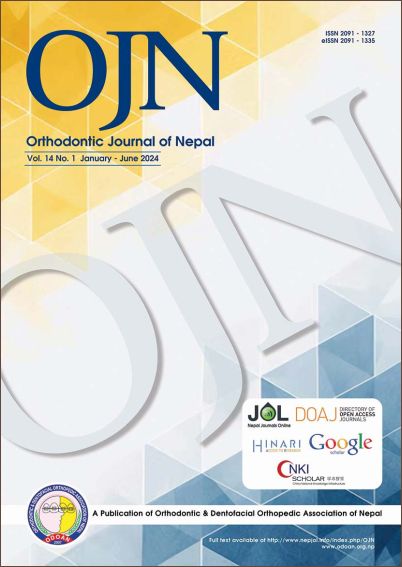Mandibular Condyle Asymmetry among Different Skeletal patterns
DOI:
https://doi.org/10.3126/ojn.v14i1.59081Keywords:
Condylar Asymmetry, Malocclusion, Skeletal PatternsAbstract
Background: A pleasing face requires symmetry in all three planes. Abnormality in the symmetric growth of condyles is one of the most common causes of facial asymmetry.
Aims and Objective: The objective of this study was to determine the vertical mandibular condyle asymmetry in different skeletal patterns and among genders.
Materials and Method: Pre-treatment lateral cephalograms of 102 subjects (equally divided into three groups: skeletal Class I, Class II and Class III) seeking orthodontic treatment were used to determine the condylar asymmetry. Condylar asymmetry was determined by comparing the heights of the mandibular condyle head and height of ramus on OPG x-rays. Intraclass correlation coefficient (ICC) was used to determine intrapersonal reliability. Mann Whitney test, Kruskal Wallis test was used to find condylar asymmetry index, ramus asymmetry index and condyle plus ramus asymmetry index across the skeletal classes.
Result: Condylar asymmetry index in Class I, Class II, and Class III patients were found to be 5.54%, 6.66%, and 3.68% respectively. Similarly, ramus asymmetry index was 2.03% for Class I, 2.40% for Class II and 1.53% for Class III. The condyle plus ramus asymmetry index was 1.67, 2.01 and 1.34 for Class I, Class II and Class III respectively. All these differences were not statistically significant.
Conclusion: The difference in asymmetry index was insignificant among the Class I, Class II and Class III malocclusions.
Downloads
Downloads
Published
How to Cite
Issue
Section
License
Copyright (c) 2024 Orthodontic & Dentofacial Orthopedic Association of Nepal

This work is licensed under a Creative Commons Attribution 4.0 International License.
Copyright © held by Orthodontic & Dentofacial Orthopedic Association of Nepal
- Copyright on any research article is transferred in full to the Orthodontic & Dentofacial Orthopedic Association of Nepal upon publication in the journal. The copyright transfer includes the right to reproduce and distribute the article in any form of reproduction (printing, electronic media or any other form).
- Articles in the Orthodontic Journal of Nepal are Open Access articles published under the Creative Commons CC BY License (https://creativecommons.org/licenses/by/4.0/)
- This license permits use, distribution and reproduction in any medium, provided the original work is properly cited.




